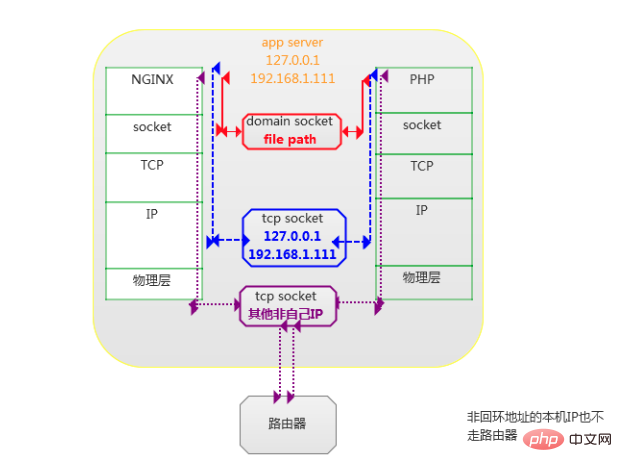 Backend Development
Backend Development
 PHP Tutorial
PHP Tutorial
 Summary of the communication mechanism between PHP-FPM and Nginx
Summary of the communication mechanism between PHP-FPM and Nginx
Summary of the communication mechanism between PHP-FPM and Nginx

[Related learning recommendations: php graphic tutorial]
PHP-FPM Introduction
CGI Protocol and FastCGI Protocol
The code files of each dynamic language (PHP, Python, etc.) need to pass the corresponding parser before they can be Server identification, and the CGI protocol is used to enable the interpreter and server to communicate with each other. The parsing of PHP files on the server requires the use of a PHP interpreter, coupled with the corresponding CGI protocol, so that the server can parse PHP files.
Since the mechanism of CGI requires forking a CGI process for each request, and then killing the process after the request is completed, which is a waste of resources in practical applications, so an improved version of CGI, FastCGI, appeared. After processing, the process will not be killed, but multiple requests will continue to be processed, which greatly improves efficiency.
What is PHP-FPM
PHP-FPM is PHP-FastCGI Process Manager. It is the implementation of FastCGI and provides process management functions. The process includes two types: master process and worker process; there is only one master process, which is responsible for listening to the port and receiving requests from the server, while there are generally multiple worker processes (the specific number is configured according to actual needs), and each process will have one embedded in it. The PHP interpreter is where the code is actually executed.
Nginx and php-fpm communication mechanism
When we visit a website (such as www.test.com), the processing flow is like this:
www.test.com
|
|
Nginx
|
|
路由到 www.test.com/index.php
|
|
加载 nginx 的 fast-cgi 模块
|
|
fast-cgi 监听 127.0.0.1:9000 地址
|
|
www.test.com/index.php 请求到达 127.0.0.1:9000
|
|
等待处理...[Related article recommendations: Nginx tutorial]
The combination of Nginx and php-fpm
On Linux, the communication between nginx and php-fpm has tcp There are two ways: socket and unix socket.
The advantage of tcp socket is that it can cross servers. This method can only be used when nginx and php-fpm are not on the same machine.
Unix socket is also called IPC (inter-process communication) socket, which is used to implement inter-process communication on the same host. This method requires filling in the socket file location of php-fpm in the nginx configuration file. .
The data transmission process of the two methods is shown in the figure below: 
The difference between the two:
Because Unix socket does not need to go through the network protocol stack , there is no need to pack and unpack, calculate checksums, maintain sequence numbers and responses, etc. It just copies application layer data from one process to another. Therefore, its efficiency is higher than that of tcp socket, which can reduce unnecessary tcp overhead. However, unix sockets are unstable when concurrency is high. When the number of connections explodes, a large number of long-term caches will be generated. Without the support of a connection-oriented protocol, large data packets may directly go wrong without returning an exception. Connection-oriented protocols such as tcp can better ensure the correctness and integrity of communication.
The combination of Nginx and php-fpm only requires settings in their respective configuration files:
1) Configuration in Nginx
Take tcp socket communication as an example
server {
listen 80; #监听 80 端口,接收http请求
server_name www.test.com; #就是网站地址
root /usr/local/etc/nginx/www/huxintong_admin; # 准备存放代码工程的路径
#路由到网站根目录 www.test.com 时候的处理
location / {
index index.php; #跳转到 www.test.com/index.php
autoindex on;
}
#当请求网站下 php 文件的时候,反向代理到 php-fpm
location ~ \.php$ {
include /usr/local/etc/nginx/fastcgi.conf; #加载 nginx 的 fastcgi 模块
fastcgi_intercept_errors on;
fastcgi_pass 127.0.0.1:9000; # tcp 方式,php-fpm 监听的 IP 地址和端口
# fasrcgi_pass /usr/run/php-fpm.sock # unix socket 连接方式
}
}2) Configuration of php-fpm
listen = 127.0.0.1:9000 # 或者下面这样 listen = /var/run/php-fpm.sock
Note that when using unix socket to connect, since the socket file is essentially a file, there are permission control issues, so it is necessary Pay attention to the permissions of the nginx process and the permissions of php-fpm, otherwise you will be prompted to access without permission. (Set users in their respective configuration files)
The communication between php-fpm and nginx can be completed through the above configuration.
Selection in application
If nginx and php-fpm are running on the same server, and the concurrency is not high (no more than 1000), choose unix socket to improve nginx Communication efficiency with php-fpm.
If you are facing high concurrent business, consider using a more reliable tcp socket to maintain efficiency through operation and maintenance methods such as load balancing and kernel optimization.
If the concurrency is high but you still want to use unix socket, you can improve the stability of unix socket through the following methods.
1) Place the sock file in the /dev/shm directory. Place the sock file in the memory in this directory, so that the memory can be read and written faster.
2) Increase the backlog
Backlog default bit 128, 1024, this value is replaced by your normal QPS, the configuration is as follows.
nginx.conf file
server {
listen 80 default backlog = 1024;
}php-fpm.conf file
listen.backlog = 1024
3) Add sock file and php-fpm instance
in/ Create a new sock file in dev/shm, load balance requests to two sock files through the upstream module in nginx, and map the two sock files to two sets of php-fpm instances.
The above is the detailed content of Summary of the communication mechanism between PHP-FPM and Nginx. For more information, please follow other related articles on the PHP Chinese website!

Hot AI Tools

Undresser.AI Undress
AI-powered app for creating realistic nude photos

AI Clothes Remover
Online AI tool for removing clothes from photos.

Undress AI Tool
Undress images for free

Clothoff.io
AI clothes remover

Video Face Swap
Swap faces in any video effortlessly with our completely free AI face swap tool!

Hot Article

Hot Tools

Notepad++7.3.1
Easy-to-use and free code editor

SublimeText3 Chinese version
Chinese version, very easy to use

Zend Studio 13.0.1
Powerful PHP integrated development environment

Dreamweaver CS6
Visual web development tools

SublimeText3 Mac version
God-level code editing software (SublimeText3)

Hot Topics
 1387
1387
 52
52
 How to configure cloud server domain name in nginx
Apr 14, 2025 pm 12:18 PM
How to configure cloud server domain name in nginx
Apr 14, 2025 pm 12:18 PM
How to configure an Nginx domain name on a cloud server: Create an A record pointing to the public IP address of the cloud server. Add virtual host blocks in the Nginx configuration file, specifying the listening port, domain name, and website root directory. Restart Nginx to apply the changes. Access the domain name test configuration. Other notes: Install the SSL certificate to enable HTTPS, ensure that the firewall allows port 80 traffic, and wait for DNS resolution to take effect.
 How to start nginx server
Apr 14, 2025 pm 12:27 PM
How to start nginx server
Apr 14, 2025 pm 12:27 PM
Starting an Nginx server requires different steps according to different operating systems: Linux/Unix system: Install the Nginx package (for example, using apt-get or yum). Use systemctl to start an Nginx service (for example, sudo systemctl start nginx). Windows system: Download and install Windows binary files. Start Nginx using the nginx.exe executable (for example, nginx.exe -c conf\nginx.conf). No matter which operating system you use, you can access the server IP
 How to check nginx version
Apr 14, 2025 am 11:57 AM
How to check nginx version
Apr 14, 2025 am 11:57 AM
The methods that can query the Nginx version are: use the nginx -v command; view the version directive in the nginx.conf file; open the Nginx error page and view the page title.
 How to check the name of the docker container
Apr 15, 2025 pm 12:21 PM
How to check the name of the docker container
Apr 15, 2025 pm 12:21 PM
You can query the Docker container name by following the steps: List all containers (docker ps). Filter the container list (using the grep command). Gets the container name (located in the "NAMES" column).
 How to run nginx apache
Apr 14, 2025 pm 12:33 PM
How to run nginx apache
Apr 14, 2025 pm 12:33 PM
To get Nginx to run Apache, you need to: 1. Install Nginx and Apache; 2. Configure the Nginx agent; 3. Start Nginx and Apache; 4. Test the configuration to ensure that you can see Apache content after accessing the domain name. In addition, you need to pay attention to other matters such as port number matching, virtual host configuration, and SSL/TLS settings.
 How to check whether nginx is started
Apr 14, 2025 pm 01:03 PM
How to check whether nginx is started
Apr 14, 2025 pm 01:03 PM
How to confirm whether Nginx is started: 1. Use the command line: systemctl status nginx (Linux/Unix), netstat -ano | findstr 80 (Windows); 2. Check whether port 80 is open; 3. Check the Nginx startup message in the system log; 4. Use third-party tools, such as Nagios, Zabbix, and Icinga.
 How to create a mirror in docker
Apr 15, 2025 am 11:27 AM
How to create a mirror in docker
Apr 15, 2025 am 11:27 AM
Steps to create a Docker image: Write a Dockerfile that contains the build instructions. Build the image in the terminal, using the docker build command. Tag the image and assign names and tags using the docker tag command.
 How to start containers by docker
Apr 15, 2025 pm 12:27 PM
How to start containers by docker
Apr 15, 2025 pm 12:27 PM
Docker container startup steps: Pull the container image: Run "docker pull [mirror name]". Create a container: Use "docker create [options] [mirror name] [commands and parameters]". Start the container: Execute "docker start [Container name or ID]". Check container status: Verify that the container is running with "docker ps".



